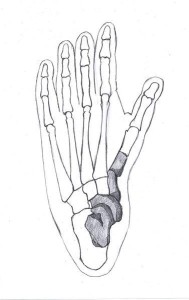14. Australopithecus prometheus or africanus
Australopithecus prometheus or africanus
“Little Foot” (~3.6–3.2 mya)
(“southern ape” / Prometheus / Africa)

SITES
Sterkfontein and possibly Makapansgat, South Africa
PEOPLE
Ronald Clarke
INTRODUCTION
The controversial material that has come to be known as “Little Foot” is an almost complete skeleton from the site of Sterkfontein (see Au. africanus for more information on Sterkfontein). The story is remarkable in that the skeletal components were discovered at two different times. The earlier material was catalogued and stored as “cercopithecoid” (Old World monkey) remains. Fifteen years later, the rest of the skeleton was found at the same location at Sterkfontein (Silberburg Grotto) and matched to the previous material. The only other case that I know of where something like that happened was at the Swanscombe, England, site where three skull bones from a Homo heidelbergensis individual were found in three different years.
PHYLOGENY
Ronald Clarke believes that there were two species of australopith at Sterkfontein. He has assigned the species name Australopithecus prometheus to the Little Foot material, as well as two individuals that others assign to Au. africanus, one from Sterkfontein and the other from Makapansgat. While the phylogeny is unknown, Little Foot precedes and may be the ancestor of Au. africanus.
DISCOVERY AND GEOGRAPHIC RANGE
The “cercopithecoid” material was discovered by Ronald Clarke in a storeroom at the University of the Witwatersrand. Once he realized that the bones were hominin and had thus been miscatalogued, he sent his two assistants, Stephen Motsumi and Nkwane Molefe, out to the original site to see if they could find more … and they did! The species’ geographic range is presently limited to the Sterkfontein area of South Africa (Duke 1998).
PHYSICAL CHARACTERISTICS
Little Foot is characterized as a climbing biped, as it had both arboreal and bipedal characteristics. Arboreal characteristics consisted of upward-oriented shoulder joints; ape-like arms that were, however, shorter than those of other southern australopiths; and curved hand and foot bones. Surprisingly, the few foot bones that were recovered are more complete than in any previous australopith specimen (see Figure 14.1). The morphology is transitional in that they retained some ape-like morphology. The hallux displayed the same degree of divergence as other australopiths. The upper limb combined both ape- and human-like characteristics. While the upper limb was shorter relative to australopiths, the hand bones remained curved. While the Little Foot specimen was ~4′ tall, males and females are estimated to have been 3′6″ and 4′6″ tall and 60–120 lb in weight, respectively.
ENVIRONMENT AND WAY OF LIFE
The environment of Sterkfontein is discussed in the section on Au. africanus.
Review of Primitive Characteristics
- Climbing adaptations:
- Upward-oriented shoulder girdle.
- Ape-like arms.
- Curved hand and foot bones.
Review of Derived Characteristics
- Shorter arms relative to australopiths.

